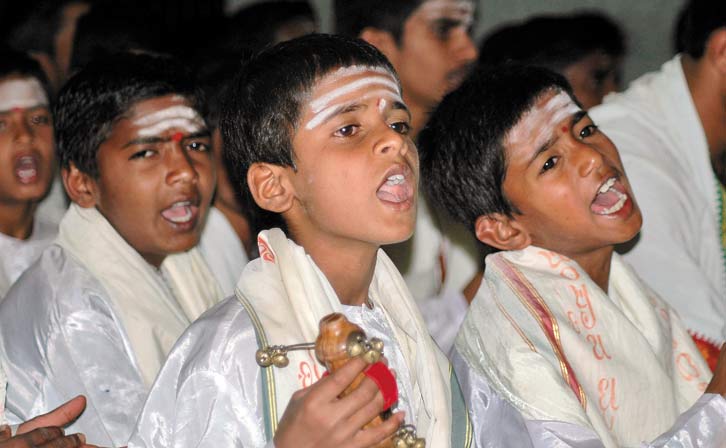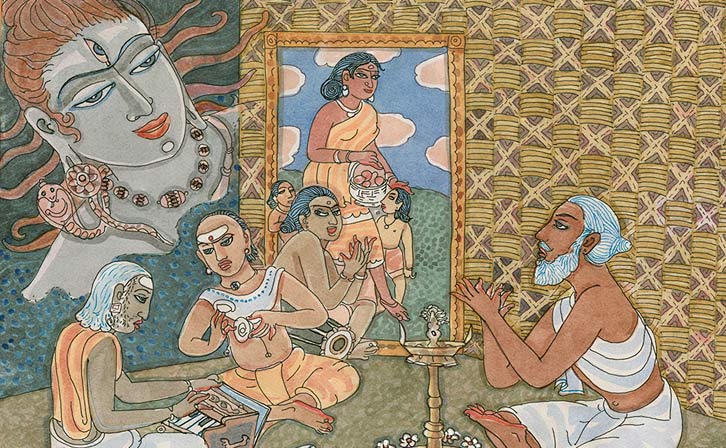The World of Siva's Sacred Song
Let us pour forth a rain of songs
to melt the very stones!
This is your gateway to a small but growing collection of sacred songs. Most are sung by the devotees of the Kailasa Parampara and include recordings at all levels, trained Carnatic singers, bhajan groups, children, teenagers and non-professionals. When you choose a collection, the results will appear on another page and you can click to go to a player to listen and, in some cases, follow along with lyrics.
Sacred Songs Library Overview
We are gradually collecting Saivite songs for our devotees to sing and eventually teach in 324 classes spanning a nine-year syllabus on the Saivite Hindu Religion for children ages six through foruteen. In each of the 36 weekly classes to be taught annual, there will be an audio component where children will learn songs and chants. Below are some overview notes on this program.
Reclaiming Song As Sadhana
Singing to the Gods is a powerful form of sadhana, an expression of bhakti that opens the heart, lifts the spirit and directs our energies toward the Divine. Yogaswami and his devotees sang everyday. There was a time when everyone sang. Perfection in musical performance was valued and respected by not a requirement. We all knew songs and we all enjoyed singing. Then came radio, later records, audio CDs, television, movies and the internet. The realm of song became the domain of professionals and lay people became silent listeners. Today we have whole groups of people who never sing and never even think of singing as something they might do.
We encourage anyone with interest and talent to pursue the study of sangeetam. Cultural development is an important part of education. And we need those with talent and passion reach the heights of their artform. And some level of understanding and skill in music is useful for anyone. But the end goal is devotion and not entertainment (or worse—competition, which leads to discouragement among youth), which is a more modern phenomenon. There was a time when great singers in India would never sing on stage. They sang only in temples or satsangs or on the streets as way to praise God. After artists lost the patronage of the wealthy classes, they were forced to go for entertainment as a way of survival.
One of our goals is to reclaim the practice of singing as sadhana and be less concerned with elaboration of musicality. We want to keep it simple enough for everyone to be comfortable participating and be more focused on knowing the meaning of what we sing. We want to return to song as a form of prayer and worship, for every man, woman and child, as it was in the days of the Saiva saints.
Genre
For our educational and sadhana purposes we have established a set of genre specific to our needs and which reflect the both mode of the songs as well as the difficulty. These genres also serve to organize songs along the lines of our actual usage in our community religious life.
- Bhajans:These are short simple songs, which repeat the names of the Gods or have very short phrases. They typically are led by one singer who knows the song. Everyone else is silent while the leader sings; and then the whole group repeats the line or verse. Because they are simple, generally the group can repeat the song without requiring a song book. In this mode, the leader leads and the followers follow. The leader may repeat the same line several times, or increase the tempo on subsequent repetitions and then finally finish with one slow verse or line. We need to let the leader lead, so that he or she can also finish and end the song, and we all know that is the end.
- Bhakti Gitam: "Gitam" means song and in our usage refers to a more complex composition. It must be memorized, or you would need to have the lyrics to read and follow along. Performance is in two modes: some songs are sung straight through, one time only, with every one singing who knows the song. For shorter gitam, it is also common to repeat the lines once. But still the song is sung only once through, even if the lines are repeated. It is up to the leader (whoever starts the song) to sing it straight through or repeat each line. In this mode, everyone who knows the song may join in both singing the first instance and also singing the second repetition. It is recommended that if you do not know the song well, then be silent and listen very carefully to the first repetition. This way you will learn it faster. Later when you know the song well you can sing both times along with the leader.
- Natchintanai: These are a special class of gitam. They are songs composed by Siva Yogaswami our Parama Guru. If you can imbibe the spirit of Siva Yogaswami's message into your own heart, life and action, you will be, as he himself says, surely liberated in this life. We follow the same principle here: everyone who knows the songs, sings along in unison with whoever starts the song. In a case like this, everyone who knows the song is a leader. Typically for longs Natchintanai we sing them straight thru and for short ones we may repeat the verses which may consist of one or two lines.
- Stotram:These are hymns of praise, invocation and adoration normally sung in Sanskrit, but unlike chanting we use a melodic line and a tempo that is often slow and meditative. Sometimes this mode of singing is call "a dhyanam." It is typical not to keep time and let it flow naturally. For those who know classical western music, think "molto expressivo e legato".
- Tirumurai: These are the sacred songs of our Tamil Saivite saints sung for Lord Siva. For our purposes are also including "Tiruppughal" in this genre. These are songs sung by Arunagirinathar to Lord Muruga. By strict classical definition they would form there own genre, but for simplicity sake we are, for now, classifying these as "Tirumurai." The Tirumurai are classically sung as part of the formal temple worship, during and after the puja. Those who know them well may also include them in their own personal worship in the shrine room.
Sanskrit Chants
Sanskrit Chants form a separate class of audio learning. Later we will have separate web pages just for chants. They will also be part of our Saivite Hindu Religion curriculum.
Selected for Learning
A special note on the songs that are marked "selected for learning." For Yogaswami's songs called "Natchintanai," we are slowly choosing simple standard tunes which everyone will learn so that when someone asks "How do I sing it; what tune should we teach?" we are all teaching and learning the same tune. Of course there are many tunes for songs in Hinduism and there is no "law" that says you must sing it only this way. Indian music allows for a lot of improvisation. On the other hand, to make Natchintanai songs global and popular they each need one melody that we all know well. The same applies to many bhajans. Consider perhaps the most famous song in Hinduism: the Arati Song: "Aum Jeya Jagadisha Hare...." This song is sung with the same tune all over the world, thus opening the door for everyone to join in singing it, instead of just listening to someone perform it. Sometimes the deity in the arati song is changed, but the tune is always the same. Entire crowds of people will join in singing together because everyone knows the melody. Everyone is encouraged to learn and teach the "Selected For Learning" tune. If others sing it differently, that is OK, but at least we should be able to all join in the standard tune with ease. This way devotees going to Mauritius, Canada, Malaysia or USA can all sing along together.


